The iPad Air Review
by Anand Lal Shimpi on October 29, 2013 9:00 PM ESTGPU Performance
Since the iPad Air uses the same A7 silicon as the iPhone 5s, it also uses the same on-die GPU as the 5s: IMG’s PowerVR G6430. This is a 4-cluster configuration of IMG’s latest graphics hardware, running at some relatively high frequency. I already went into some detail on the G6430 in our 5s review so I won’t rehash that here, but we’re basically looking at a shift to a more efficient scalar architecture.
I still don’t have confirmations of clock speeds, but I believe we’re looking at a max GPU clock of around 450MHz. As you’ll see from the results below, there’s a small difference in performance between the iPad Air and iPhone 5s in terms of peak GPU performance - implying very similar clocks. The difference is the iPad Air should be able to sustain its max frequency longer than the iPhone 5s can.
| Mobile SoC GPU Comparison | ||||||||||||
| PowerVR SGX 554MP4 | PowerVR G6430 | PowerVR G6430 | ||||||||||
| Used In | iPad 4 | iPhone 5s | iPad Air | |||||||||
| SIMD Name | USSE2 | USC | USC | |||||||||
| # of SIMDs | 32 | 4 | 4 | |||||||||
| MADs per SIMD | 4 | 32 | 32 | |||||||||
| Total MADs | 128 | 128 | 128 | |||||||||
| GFLOPS @ 300MHz | 76.8 GFLOPS | 76.8 GFLOPS | 76.8 GFLOPS | |||||||||
| GFLOPS as Shipping | 68.1 GFLOPS (?) | 115.2 GFLOPS | 115.2 GFLOPS | |||||||||
Since we’re talking about an A7 here and not an X-series SoC, there’s still only a 64-bit wide memory interface. As memory bandwidth is a key enabler of GPU performance I was curious to see how GPU performance compared to the outgoing iPad 4 with its much wider memory interface. Do keep in mind that the A7 does include a large system cache on-die, which can help improve effective memory bandwidth.
GFXBench 2.7
We'll start our GPU performance analysis with a look at low level results using GFXBench/GLBenchmark 2.7. The low level tests, particularly the offscreen ones, should give us some idea as to whether or not there's any increase in GPU frequency for the iPad Air vs. iPhone 5s implementations of A7.
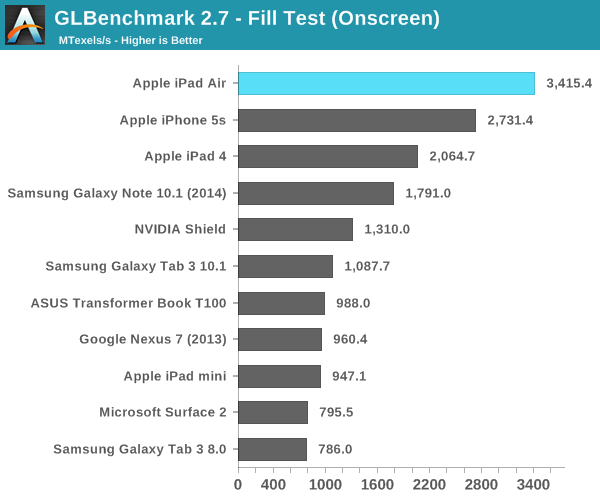
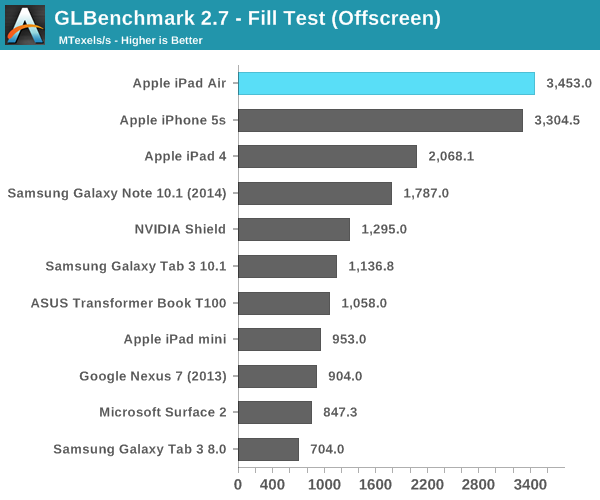
Looking at the fill rate results, there's a 4.5% increase in performance compared to the iPhone 5s. That could be the magnitude of clock increase that we're seeing between A7s. Apple could very well be relying on more thermal headroom in the iPad Air to provide any real world GPU performance advantages over the iPhone 5s.
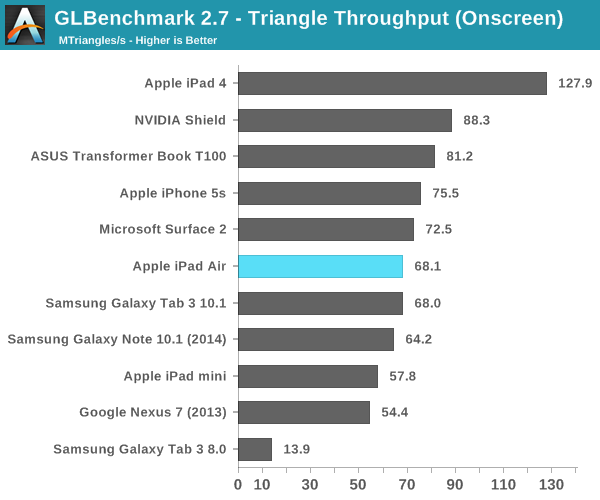

We see an even smaller gap between the Air and 5s in the triangle throughput tests (2.9%). There doesn't seem to be any substantial difference in GPU frequency between A7 implementations here. The regression in triangle rate performance compared to the iPad 4 is explained by differences in how Series 6 and Series 5XT GPUs scale in width. Whereas 5XT replicated nearly the entire GPU for "multi-core" versions, multi-cluster versions of Rogue only replicate at the shader array. The result? We don't see the same sort of peak triangle setup scaling we did back on multi-core 5XT parts. I'm not sure I'm particularly happy with the magnitude of the regression here, but I haven't seen any real world cases where it matters yet.
Next up are the game simulation tests. We'll start with the more strenuous of the two: T-Rex HD.
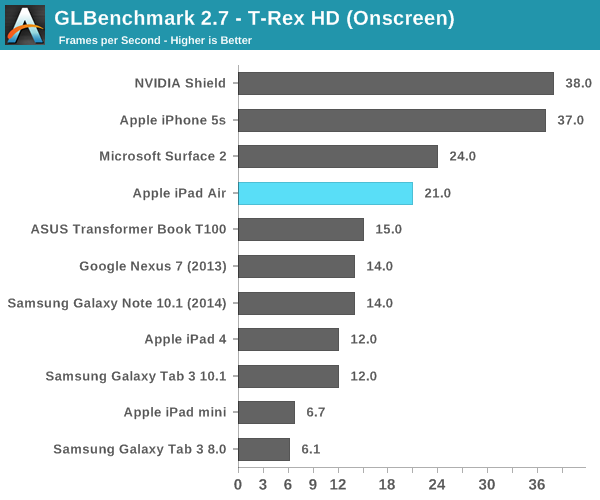
Here we get closer to Apple's claims of a 2x increase in performance. The iPad Air delivers 75% more performance than the iPad 4 in this test. Once again the iPhone 5s pulls ahead but that's because the onscreen tests render at display resolution, which is lower on the 5s.
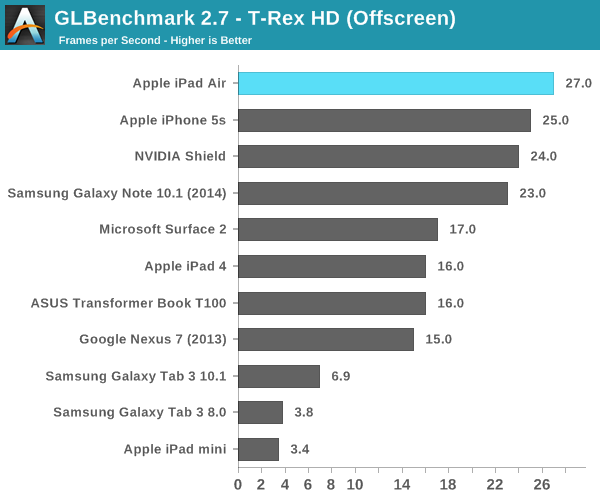
Offscreen performance sees similar scaling: ~69% better performance compared to the iPad 4.
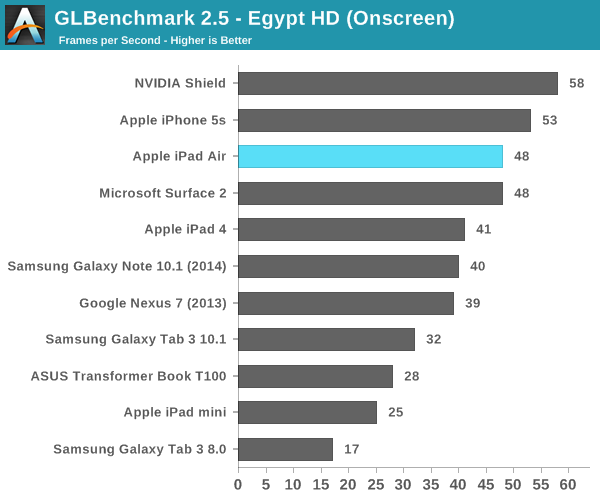
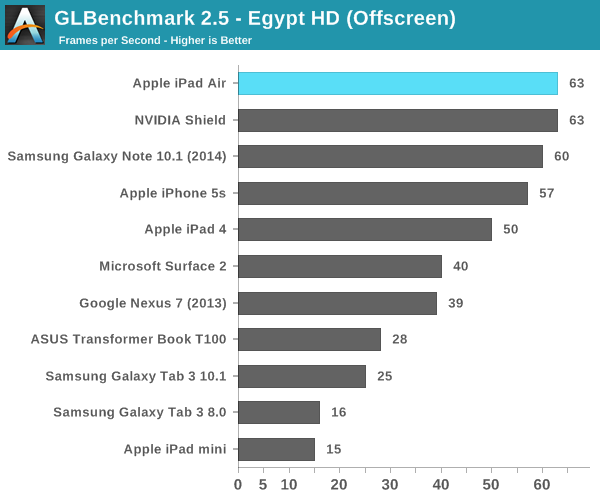
3DMark
We're once again running 3DMark's newest Unlimited mode which does its best to run independently of v-sync and at a standard resolution across all devices. I've also included 3DMark Extreme results below that feature a few more comparison points.
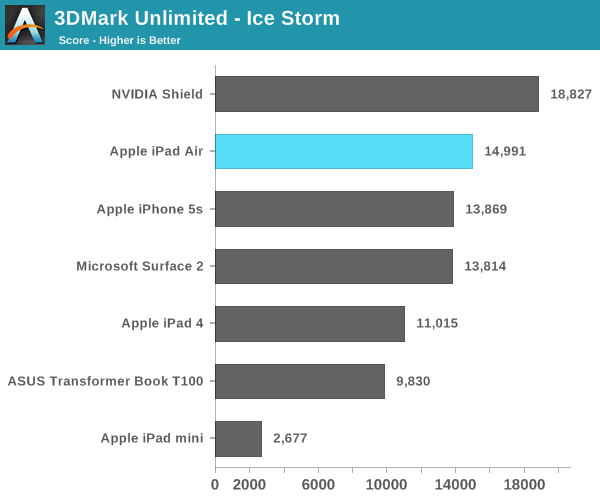
The overall Ice Storm scores show a 36% improvement in performance over the iPad 4 and an 8% increase compared to the iPhone 5s. Given the CPU frequency advantage of the A7 in the Air vs. the iPhone 5s, I'm guessing that's why we're seeing the performance gap we are here.
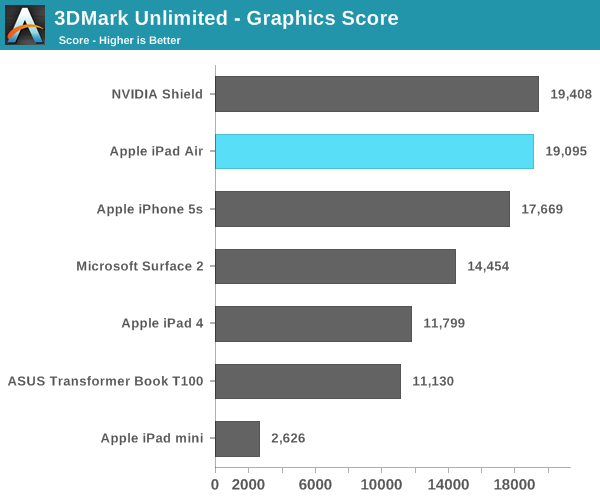
If we focus exclusively on the GPU tests (which themselves are still CPU bound), the iPad Air's performance advantage over the iPad 4 grows to over 60%.
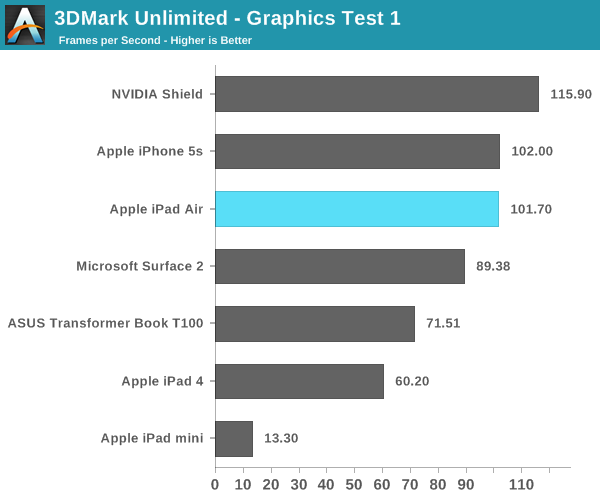
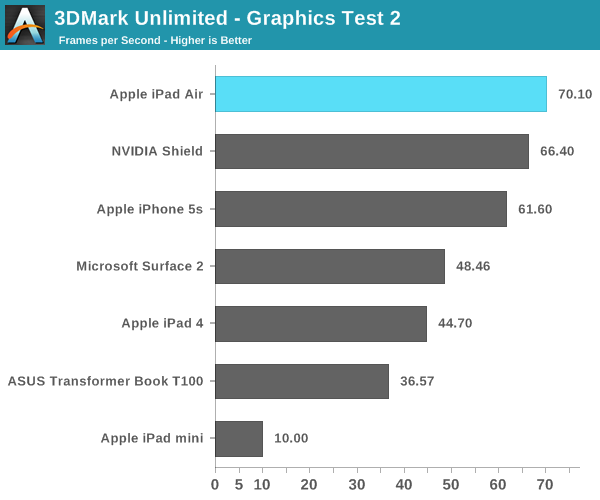
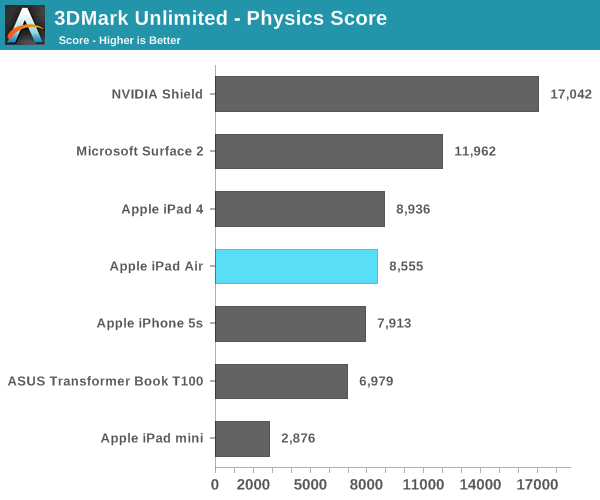
I'm still not entirely sure what's going on with the 3DMark Physics test, but we've seen this two reviews in a row now where Cyclone showed no performance increase at all compared to Swift despite this being largely a CPU test.
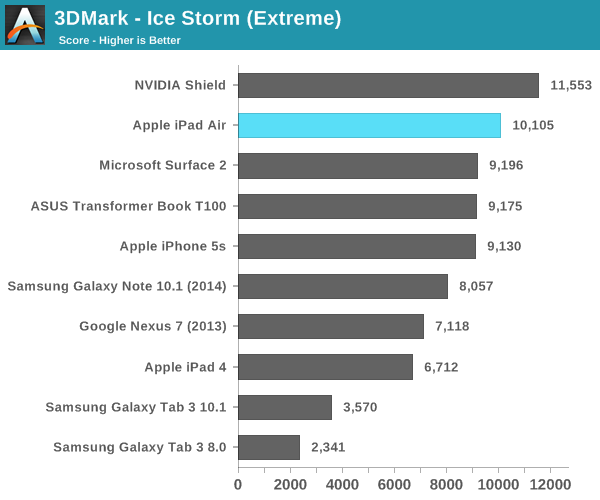
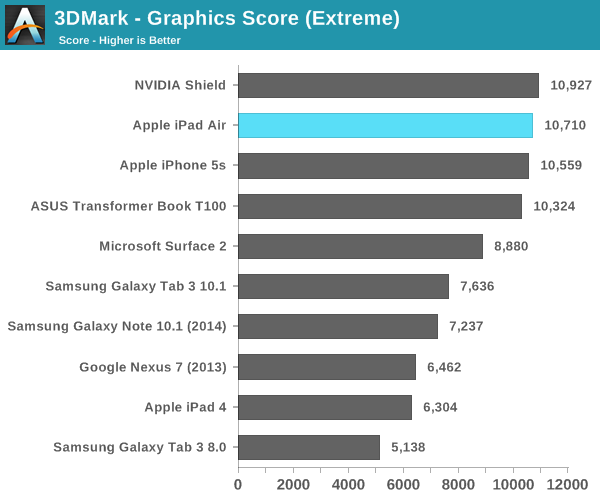
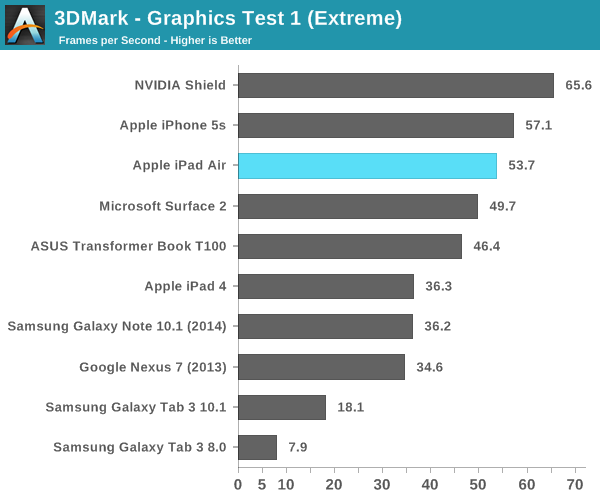
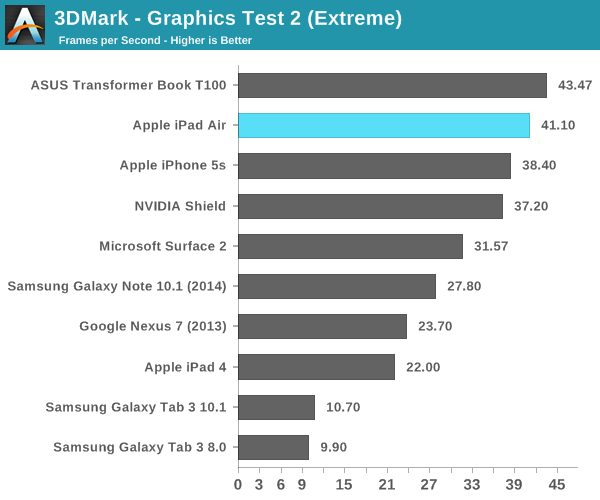

Basemark X
Basemark X is a new addition to our mobile GPU benchmark suite. There are no low level tests here, just some game simulation tests run at both onscreen (device resolution) and offscreen (1080p, no vsync) settings. The scene complexity is far closer to GLBenchmark 2.7 than the new 3DMark Ice Storm benchmark, so frame rates are pretty low.
I'm still having random issues with Basemark X reliably running both on and offscreen tests on iOS 7. Unfortunately I could only get onscreen results for the iPad Air, which came in at 46% faster than the iPad 4. Note the iPad mini and iPhone 5s benefit from having lower native resolutions here, which is why they perform so well.
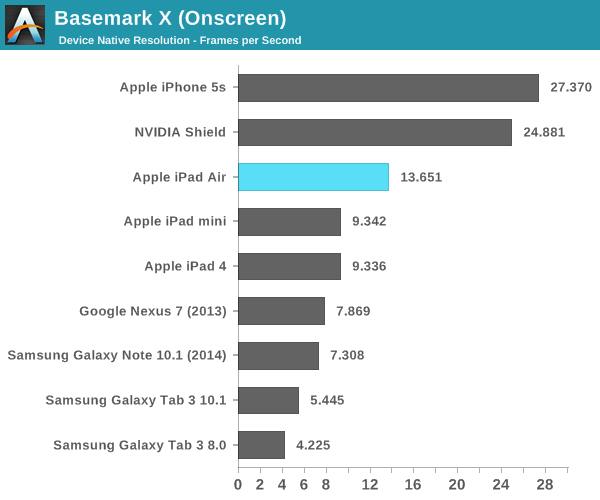










444 Comments
View All Comments
StigtriX - Tuesday, November 12, 2013 - link
Actually, the new Kindle 8.9 has at least as good a display as the iPad Air, if not better:"Amazon’s always touted the displays on its tablets, and the screen it’s using on the HDX 8.9 is a doozy. At a ridiculous 2560 x 1600-pixel resolution and 339ppi, it’s either higher-resolution or more pixel-dense than virtually any other tablet on the market. It also has great viewing angles, excellent color reproduction, and high brightness levels. It’s really just a great screen, whether you’re gaming, watching video, or reading text — it’s right up there with, if not better than, the Retina display on the iPad Air."
- The Verge
"While the speakers feel like something of an afterthought, Amazon is clearly waging a battle on the display front. The company keeps upping its game, and indeed, the screen here dazzles, with 2,560 x 1,600 resolution and a pixel density of 339 pixels per inch. That's a big jump up from the HD 8.9's 1,920 x 1,200 display, not to mention the new HDX 7-inch tablet, which has a 1,920 x 1,200 screen. It's even enough to make the iPad Air's 2,048 x 1,536 resolution (264 ppi) seem modest. It's simply a gorgeous thing to behold, making movie watching a downright pleasure. Heck, it even managed to make Sharknado look pretty good, which is no small feat. All in all, images are sharp, the level of detail is impressive and the colors are vibrant."
- Engadget
But, I do agree with you that too many let their personal opinions colour their reading of reviews. I prefer Android and PC, but I have an iPad and have tried several Macs. Even though I prefer other units, there is no point in denying the excellent quality and style Apple products come with. They, like Nintendo, only release products "when they are done" - no rushing.
MassiveTurboLag - Tuesday, October 29, 2013 - link
Really? You clearly never looked over one of their Android phone reviews. They are stupidly detailed.dsumanik - Wednesday, October 30, 2013 - link
Read this review with a grain of salt. Anand lai shimpi is heavenly vested in apple stock, doing everything he can to boost the dismal situation.Thinner bezels and light weight do not hide the fact that functionally, this iPad is the same as the previous 2 generations.
Sent from my ipad3, which will be upgraded when apple actually updates the product line.
Here's some basic ideas mr cook:
Wireless charging
Fingerprint scanner
Thunderbolt sync or usb3
Haptic feedback
NFC
Solon - Wednesday, October 30, 2013 - link
Wireless charging - deeply inefficient charging; maybe 50% of energy is actually picked up by the deviceFingerprint scanner - probably getting one next gen
Thunderbolt sync or USB3 - maybe; and it is possible the hardware already can do this; but Thunderbolt (a PCI-E spec) will never happen
Haptic feedback - dead concept; no one actually wants this; RIM failed at haptic
NFS - in a tablet? and is NFC actually used? No, it isn't.
dishayu - Wednesday, October 30, 2013 - link
Agree with your wireless charging argument, but that limits you from charging your iDevice if you don't have your own cable. All android phones use microusb, so it's not hard to find one at all (speaking of the real world here). Apple chose not to afford themselves that luxury.Fingerprint scanner : Although I think it's a gimmick and useless for the masses (almost everyone except from corporate users), they could have done it now, since they already have it in 5s. Why wait till next gen?
Haptic feedback : You probably would have said the same about touchscreens around 2005. I tried staying away from smartphones altogether until the Xperia Pro because there were no decent phone with a proper keyboard. After that I finally gave in an bought the HTC One and I still really miss my physical buttons. Haptic feedback could cure that.
NFC : I use it as much as I use Bluetooth (which is to say not a whole lot but a very handy feature still and I'd like to have it)
ws3 - Tuesday, October 29, 2013 - link
Yeah. Anyone who wanted to be truly objective would stopping running all of those tests that the iPad Air does so well in. If you want to be truly balanced, you have to run a bunch of tests that the iPad sucks at too, like maybe an .apk loading test or a malware running test.zeagus - Wednesday, October 30, 2013 - link
+lulzKoolAidMan1 - Wednesday, October 30, 2013 - link
Perfectpdjblum - Thursday, October 31, 2013 - link
Anand himself has stated where his loyalties lie: He said during a podcast that his advertisers were the motivating force behind the change in the look of the website. Obviously he is a slave to his advertisers who obviously want as much crApple content on the site as possible; of course they want it be overwhelmingly positive. This crApple model generates tons of hits for theverge and it does the same for anandtech.markthema3 - Monday, November 4, 2013 - link
He changed the layout of the site to better place the advertisments on the page. That's not catering to an individual company. The conclusion that he is therefore a slave to the advertisers is unfounded.